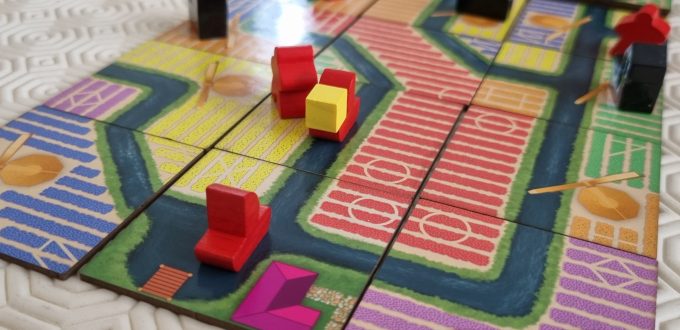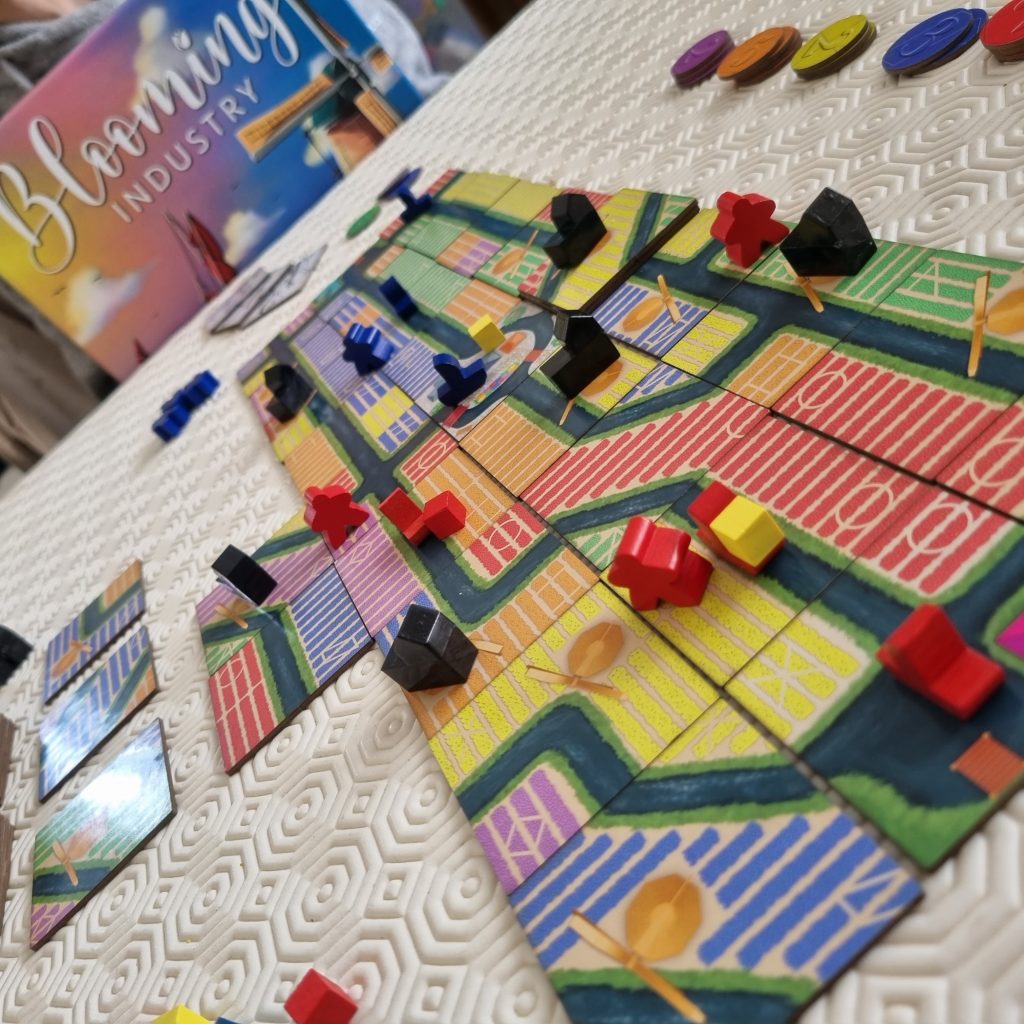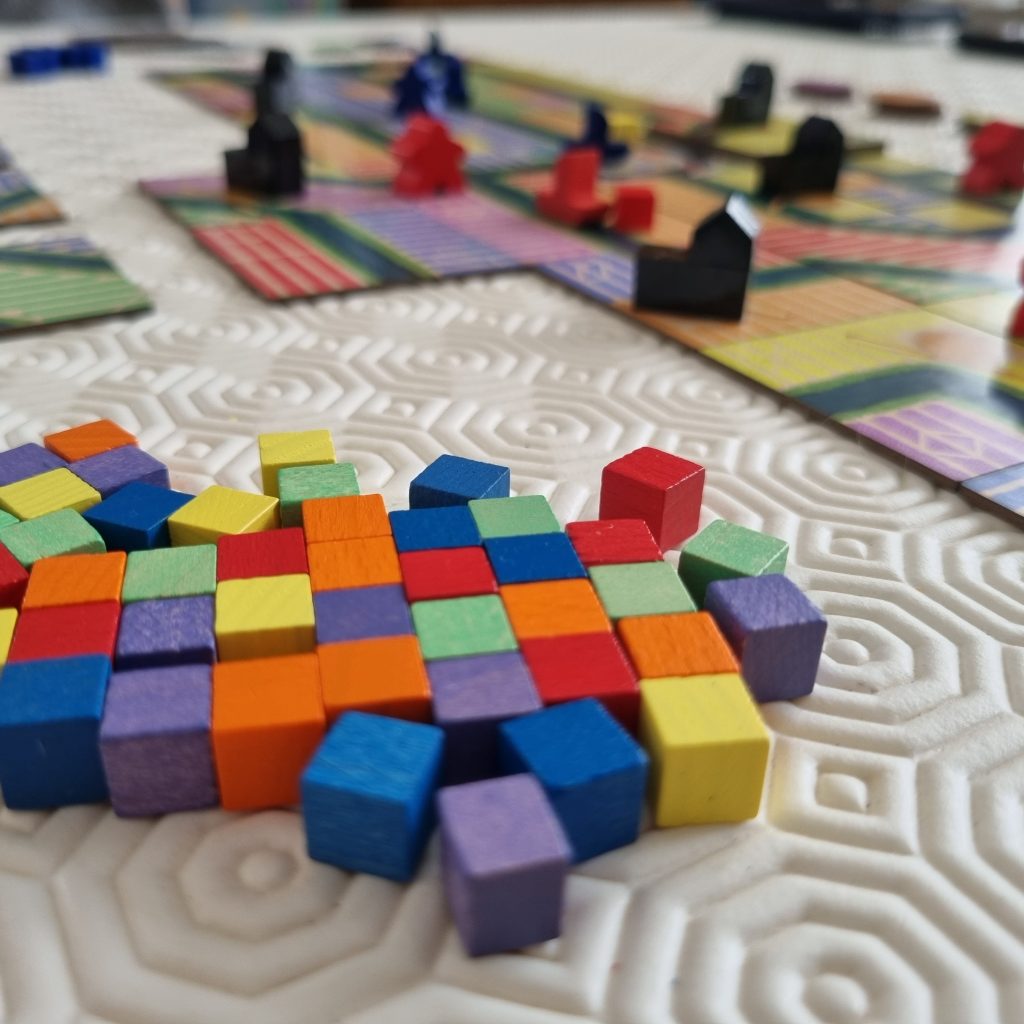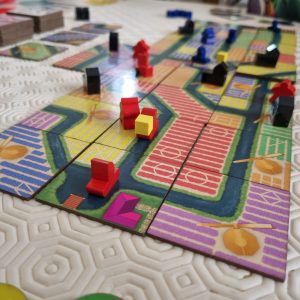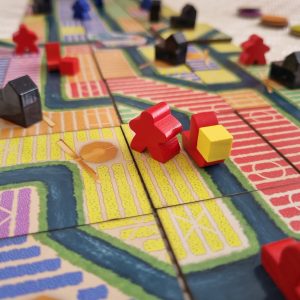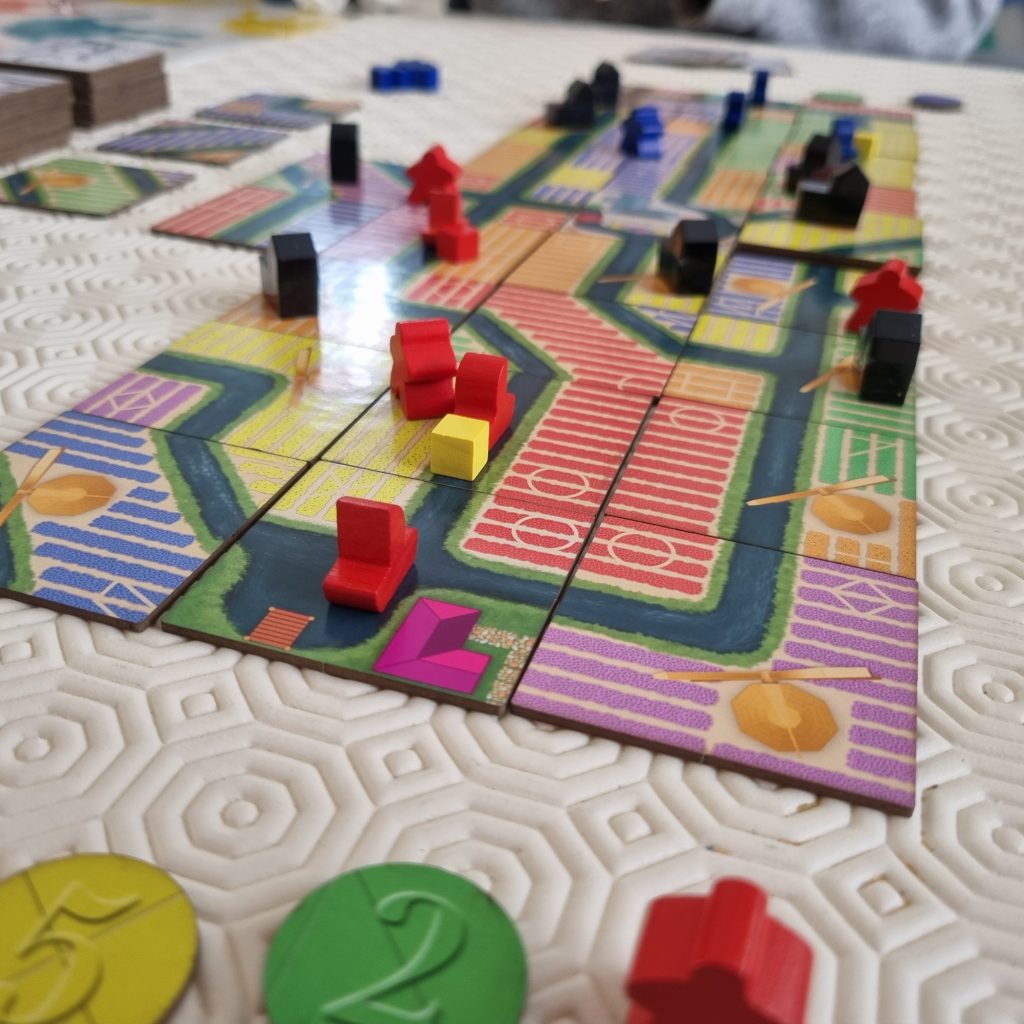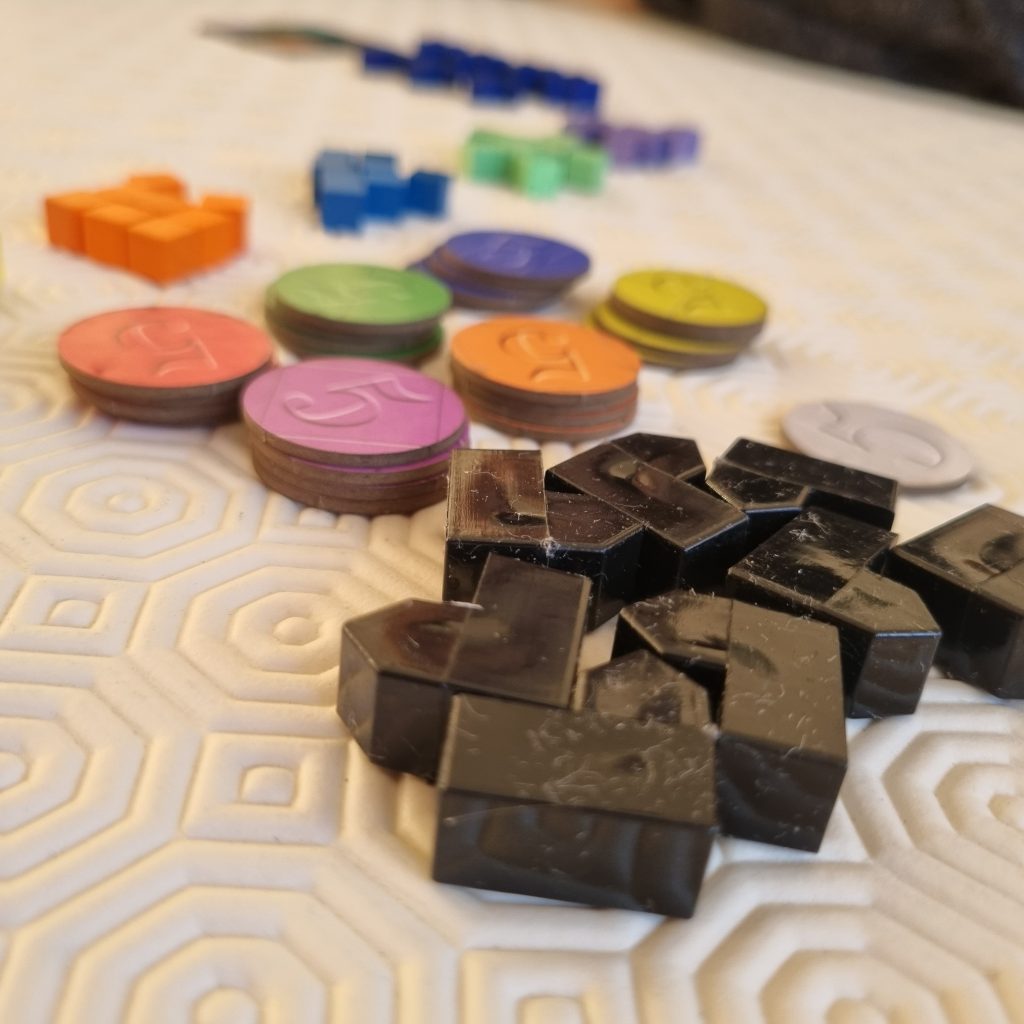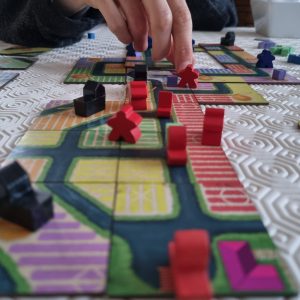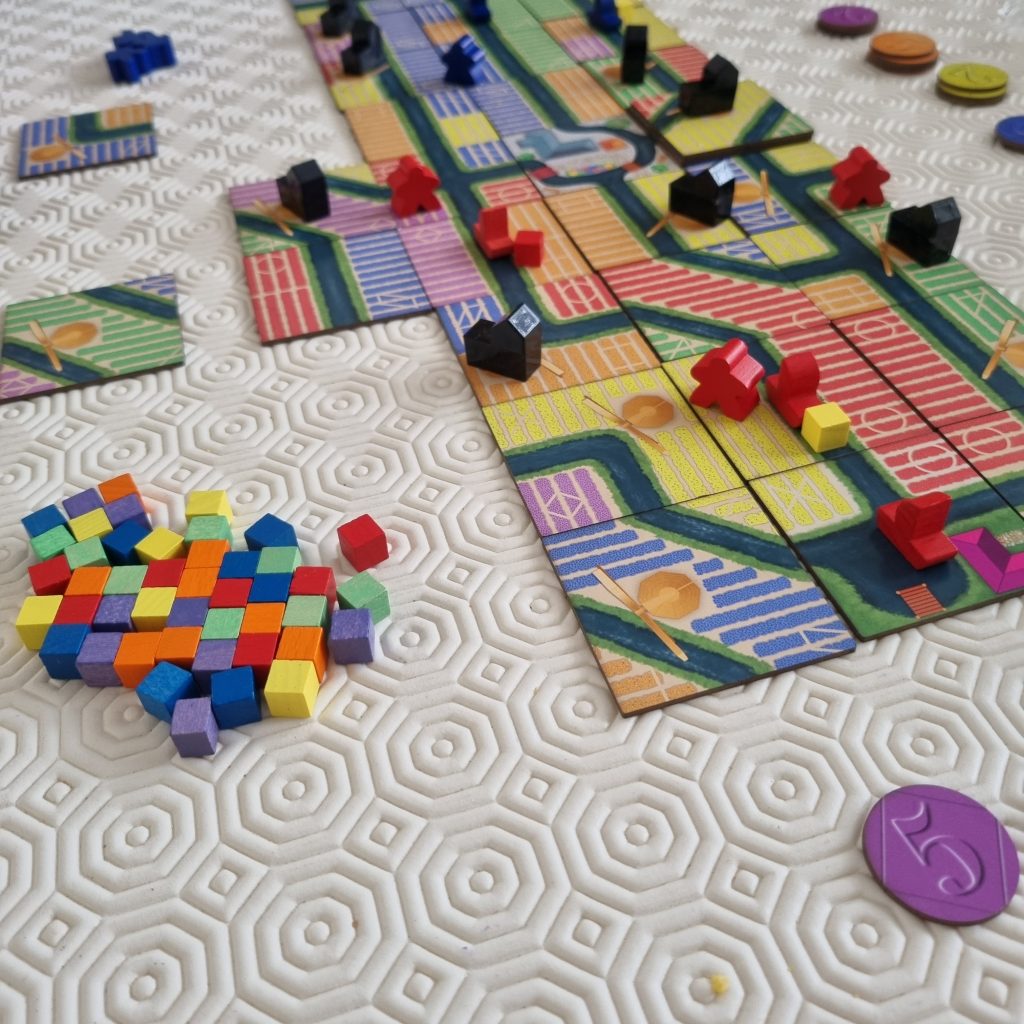Blooming Industry from Hill Goat Games is a game about harvesting, transporting and selling tulips. With tile laying, pick up and deliver, area control, networking, territory development, and worker placement, there is a lot packed into this colourful box!
Publisher: Hill Goat Games
Designer: Zachary White
Artist: Zachary White
Release date: TBC
2- 6 Players
Age: 8+
30 -60 mins
* Pick Up and Deliver* Engine Building * Network * Tile Laying * Set Collecting* Racing * Area Control *
Kickstarting the Colours!
Ok, before going on, I need to make it clear that this is a Kickstarter project. It is actually a Kickstarter campaign that launched and then stopped earlier this year. But that isn’t a bad thing. That is a sign that the Designer listened to feedback. Zach White realised that things weren’t quite right, and gave them a tweak. Full marks therefore for keeping the creative process dynamic.
And this developmental progression in Blooming Industry means that I can’t really give it a rigorous review! After all, Kickstarter isn’t a guarantee. It is the promise of something that might happen if enough money is raised. Something that might look or feel like the game shown, but not always.
What I can do, therefore, is give you my thoughts on the version I have played, just like I did in Take The Kingdom. So when I refer to Blooming Industry, please bear in mind that the final game might be a little (or a lot!) different.
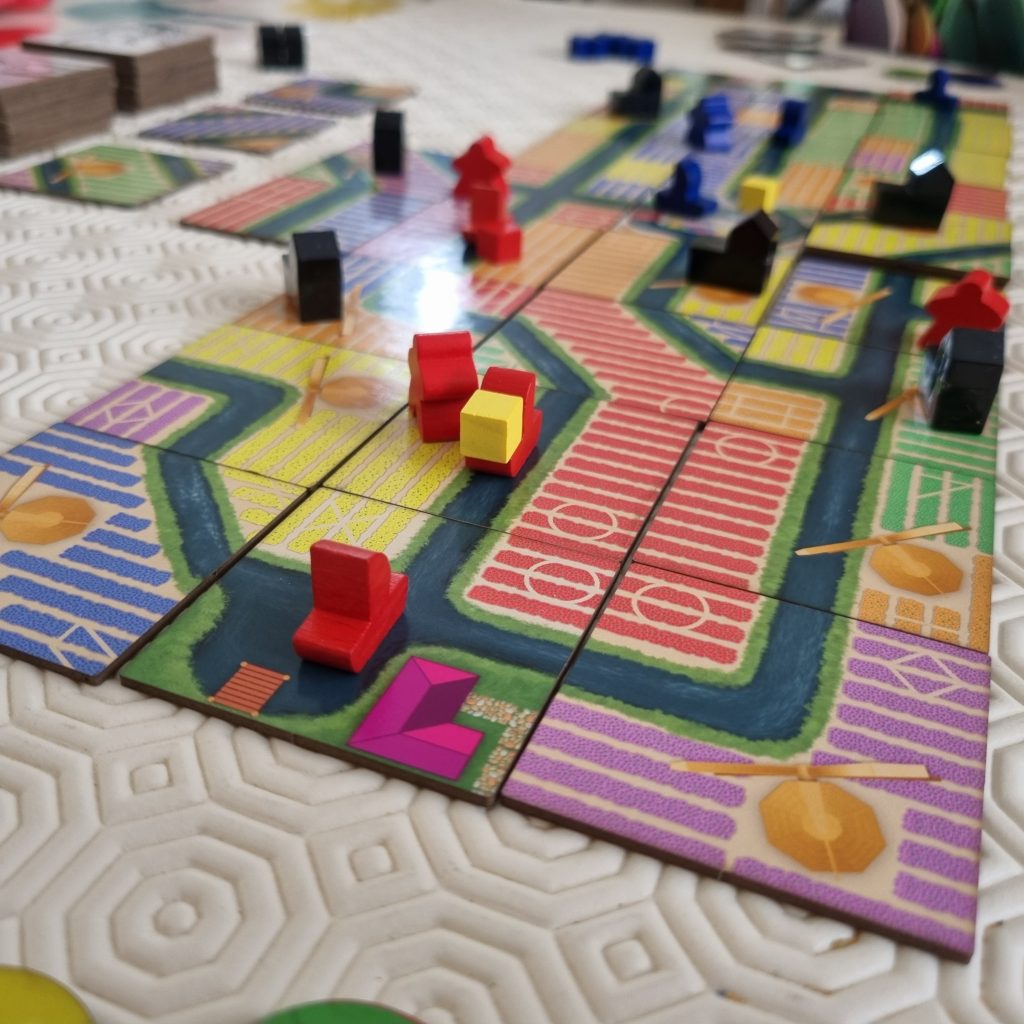
Technicolour Tulips!
So, Blooming Industry is a tile laying game. But selecting and arranging cardboard squares is just the vehicle for other mechanics. As such, you won’t win by picky placement alone. And when I say other mechanics, the list is quite long!
Pick up and Deliver? Check! Engine Building? Check! Resource Management? Check! Worker Placement? Check! Area Control? Check! Territory Building and Networking? Check! Even some Take That and Racing feature here. As such, there is a lot going on in that colourful box!

Turn around the Tulip Fields!
So how has the designer crammed so much in? Well, A turn around the tulip fields should make things a little clearer. Each go you will be taking two out of four actions. You could be picking and laying tiles to grow your fields and/or your canal network – that’s the way you link up with the central market. Or you could be disrupting another canal network to scupper opponents’ chances of selling blooms.
Alternatively, you might be placing farmers and tulips on established fields (i.e. at least 3 tiles of the same colour) in readiness to transport those sweet scented blooms to market. Finally, you could be building windmills or moving boats along their routes to market for offloading and (hopefully!) big profits!
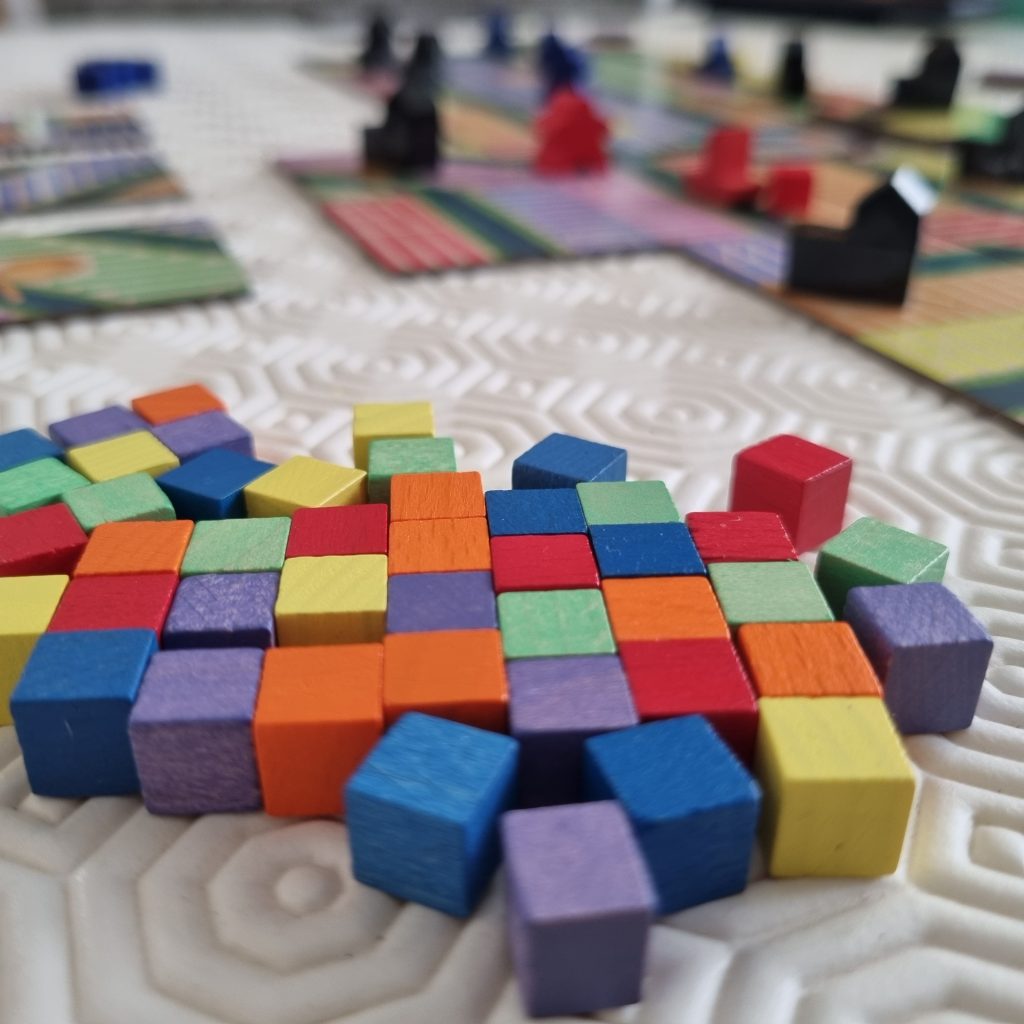
Balanced Blooms!
With the first colour of each tulip sold gaining the highest price, it pays to develop an effective and efficient canal network asap. In other words, lay straight, lay fast, and get that floral engine up and running! Once sold, those blooms are returned to the general supply, ready to be used by other players.
As we found out, a single route to market can be vulnerable to cheeky disruptions, however! Especially if the route isn’t protected against “re-seeding” through clever siting of windmills and farmers (which preclude overlaying tiles)! And although this fast track to market approach has led to some runaway leads by more spatially gifted gamers around our table, it isn’t the only way to collect serious coins.
Building out big farms that can accommodate lots of tulips throughout the course of the game (and which each score a point at the end) are colourful mini engines in their own right.
And having other strategies like stockpiling tulips on your farms also takes the emphasis away from canal networks being the only way to win. I should mention that there is no ownership in the canal routes, if you can sail there, you can use one. You aren’t limited to the tiles you have laid down.
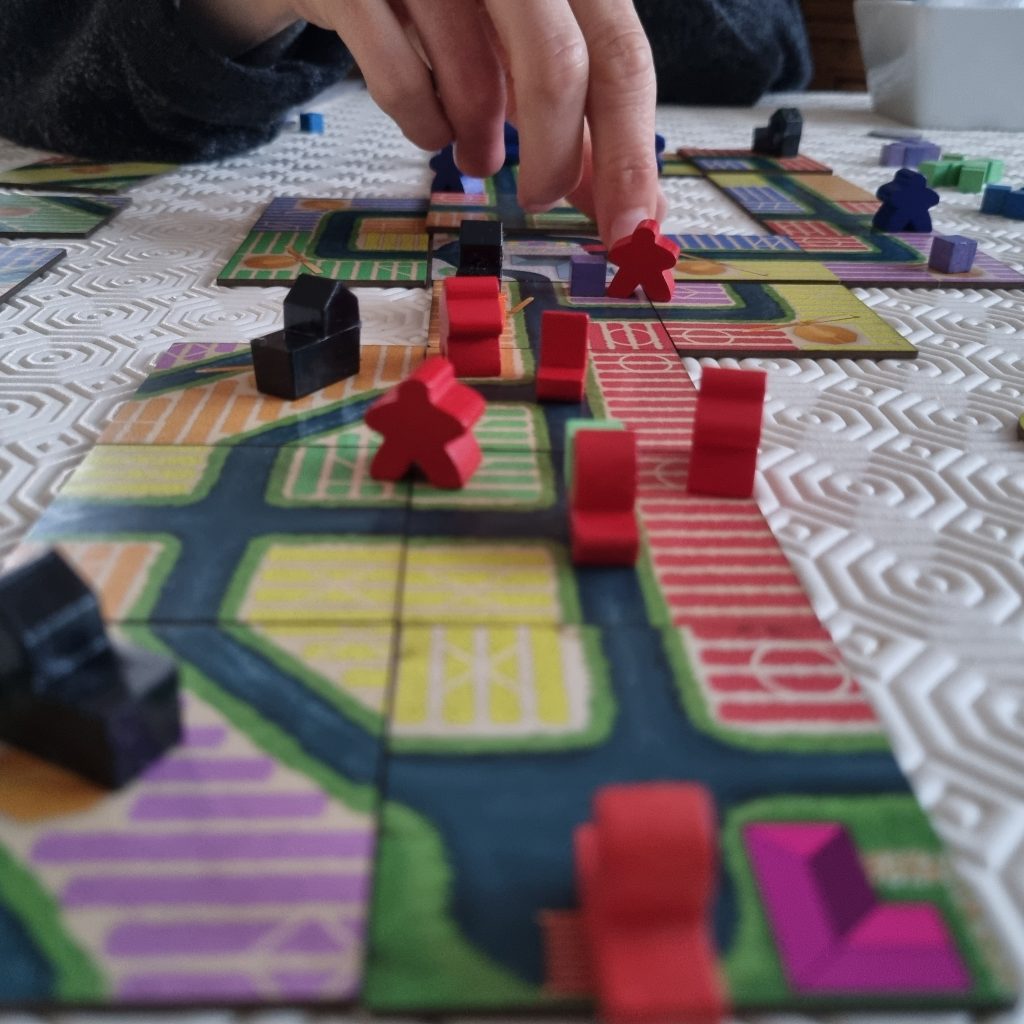
Picking Pretty Tulips!
Leaving aside the colourful crank handle on this flowery engine builder for a moment, another big mechanism in play is the pick-up and deliver (“PUD”) element. After all, Blooming Industry is about growing, moving, and selling tulips for money. And you can’t do that if you don’t collect them, transport them, and trade them at the market.
Wind Power!
But, in my mind, PUD games can sometimes feel a little ploddy, especially at lower player counts. The move one, pick up one, move again game play can feel monotonous and slow. Admit it, moving one square at a time isn’t much fun for anyone itching to get on and game.
Here, the developer has thought of a way to increase momentum somewhat. Wind power in the form of Windmills help you to move an additional tile as you pass by, which can be the difference between being first and second to market. The size of your canal network is also left up to you (and your opponents if they are in the mood to meddle!). As such, if you make it small, you can spend less time picking up, and more time selling!
Now, both availability and placement of windmills are restricted, so you won’t always be able to place one where you want (adjacent ones are not allowed for example). But, as well as increasing momentum, windmills can act as a helpful protection against network disruptions (aka engine failure)!
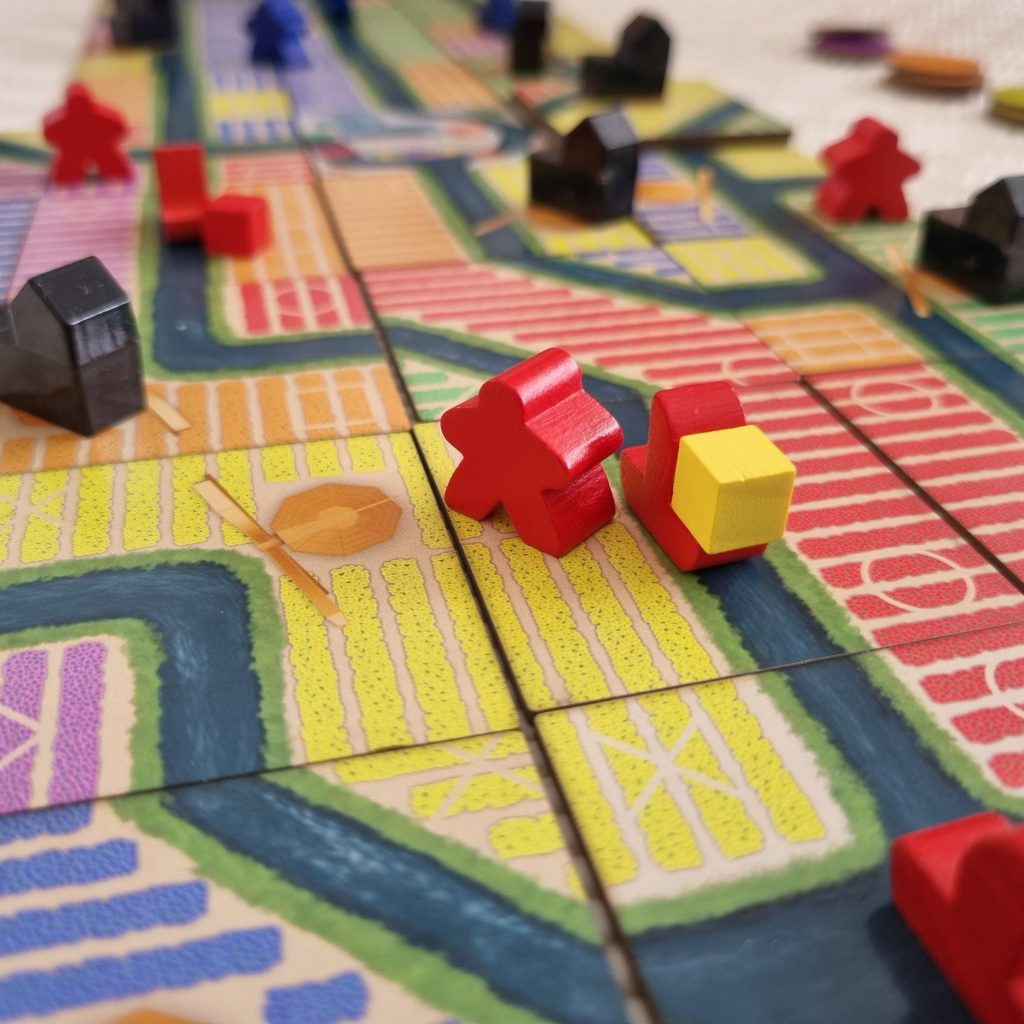
Blooming Decisions!
Although a fairly light game, each turn in Blooming Industry feels like a puzzly decision between competing and relevant options – what to do for the best now and thinking ahead to later moves. But, and here’s a sneaky snag, you can’t plan too far ahead.
This is because the feel of the game changes as you play through it. As well as the look of the play space changing over the course of sequential turns, your priorities move like tulips in the wind! Moving from tile placement early on for network and field engine establishment, through to preservation and clever resource management via farmers and boats, what you need (and what you can save!) changes.
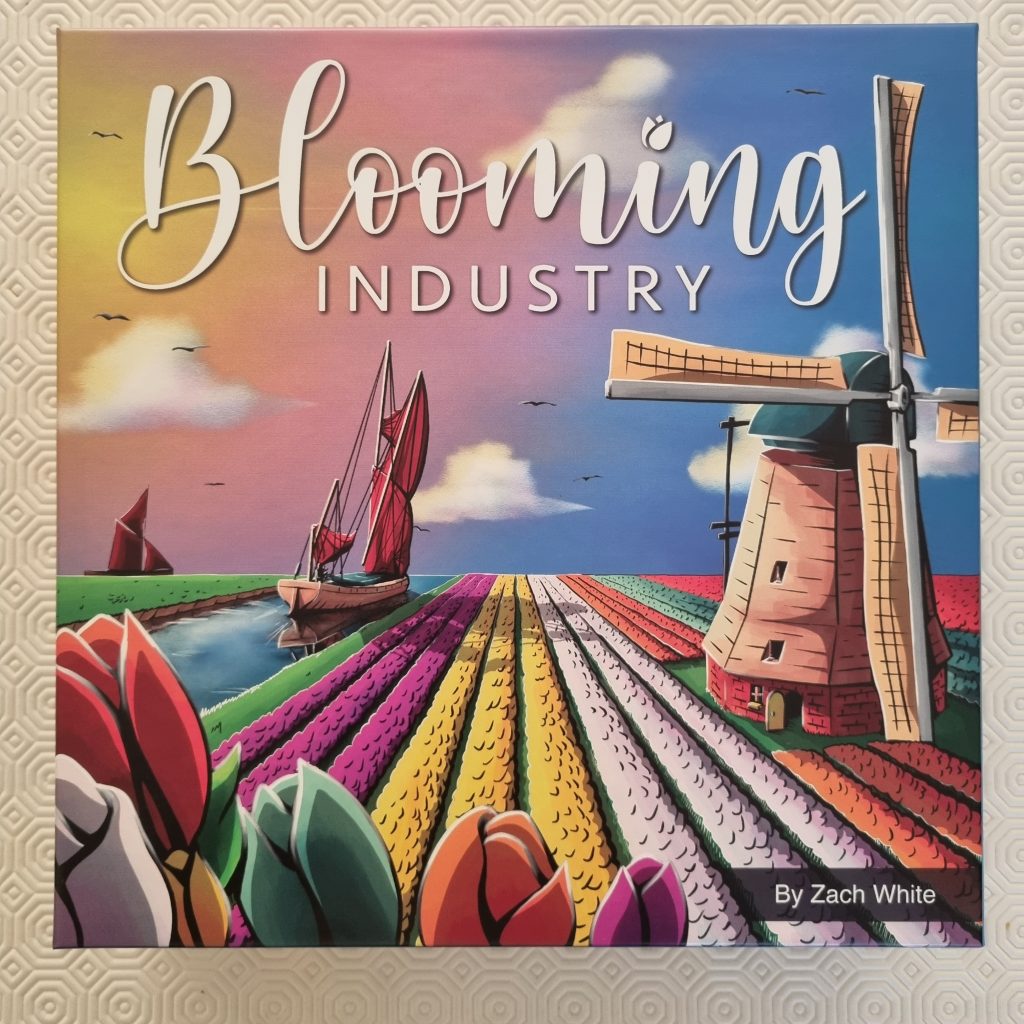
Blooming Marvellous?
Having played this version, we found Blooming Industry to be a fun puzzle, as well as a pretty sight on the table. Game time varied quite considerably depending on how many players and strategies were adopted, but I don’t think a game ran longer than about 45 minutes.
With the colours and the little thematic touches like the canal patterns and windmills, the setting works well. The square tiles we tried were also nice and chunky with vibrant printing and delicately designed backs. The symbols to assist those with colour vision deficiency to play the game without a disadvantage could be more prominent, but that might be addressed in the final design. Similarly, the prototype boats and tulip cubes we had were very small and fiddly to pick up and manoeuvre without them falling off. But again I am hopeful that this will be remedied in the final design.
If you think Blooming Industry could be a game for you, keep an eye on Hill Goat Games here (Facebook) or here (Instagram), and of course on Kickstarter for an announcement soon!

